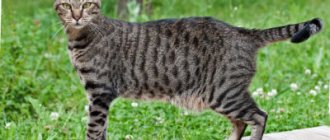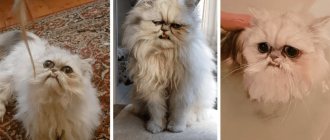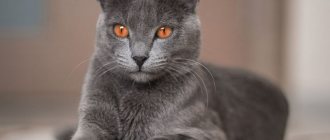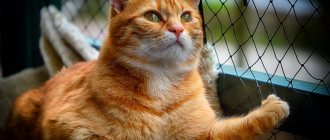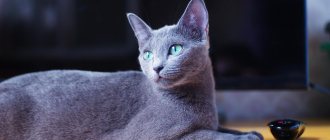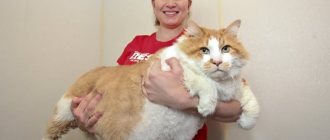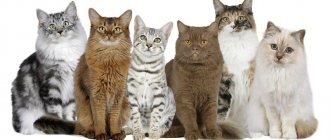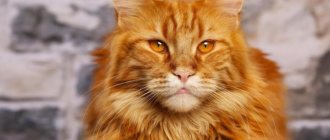The long-haired cat is a sensational cat! It was presented to pampered Europe in the 16th century by aristocrat Pietro della Valle. The famous traveler took a couple of long-haired beauties from Persia and presented them to the Pope. The Supreme Pontiff was the first to fall under the Persian spell, and after him the rest of the Italians fell, and then the French.
Historically, oriental beauties immediately fell under the patronage of noble persons. And if in Italy long-haired cat breeds conquered the Pope, then in France they lived at the court of Cardinal Richelieu. Oh, how many small and big secrets of the world behind the scenes have been seen by cats with long hair! But long-haired cat breeds are not known for being talkative, and the domestic aristocrat remains a reliable keeper of secrets.
At the same time, many note that long-haired cats are much more affectionate than their short-haired friends. They are literally created for an apartment or a house, but in their affections, they still give first place to people. For children, and for adults too, long-haired cats are ideal companions!
We will talk about the main long-haired representatives in this material.
From the history of long-haired cats
Long-haired cat breeds first appeared on the European continent approximately in the mid-16th century. They were first learned about in Italy. Representatives of these breeds gained wide popularity after Cardinal Richelieu himself got himself a long-haired cat. For a long time, these animals, due to their rarity and high cost, were the privilege of only noble and wealthy people.
Until now, long-haired cats are extremely popular not only because of their attractive appearance, but also because they are rightly considered the kindest, most affectionate, tame and flexible. These pets become attached more to the owner than to the house, unlike most other cats.
How to choose a kitten
If you have decided to acquire a representative of the beautiful LaPerm breed, you need to carefully choose a kitten. First of all, you need to decide whether you need a Show Champion or a curly-haired four-legged companion.
If you plan to exhibit a cat in competitions, then it is advisable to choose a kitten from a good nursery or from trusted breeders. It is useful to first consult with professional felinologists and veterinarians.
If you have to choose on your own, you need to remember the following health indicators:
- behavior: a physically and mentally healthy Laperma kitten is playful, eats well, shows interest in its surroundings and communicates with the rest of the kittens in the litter;
- appearance: you should not choose both the largest and smallest kittens from the litter. All parts of the body must be proportional, movements must be natural, light and relaxed;
- appetite: kittens eat often and a lot while growing;
- hygiene: there should be no discharge from the nose, eyes, ears and from under the tail;
- damage: in large litters, small kittens can sometimes accidentally scratch each other, this is acceptable if the wounds are superficial and isolated; however, it is better when the babies are unharmed;
- condition of the parents: in addition to examining the kittens themselves, you need to evaluate their parents - whether there are any diseases, hereditary or acquired, find out their age, what kind of litter they have.
It is worth finding out what treatments were carried out against parasites, whether any vaccinations were done, and clarify the names of the drugs that were used
It is important to know what foods cats are fed to make it easier to decide on food in the future. Also, we must not forget that Laperm’s fur does not curl immediately, but no later than until he is six months old.
Character
Oriental cats, despite their sometimes sad and sometimes disapproving appearance, are extremely friendly and even somewhat loving towards their owner. They are very affectionate and talkative, attracting people's attention with a whole range of different sounds.
Given this degree of attachment, they do not tolerate loneliness well. Therefore, if possible, owners often take them on trips, which the animals love very much. The pet's life is focused on the family that took him in. If you leave them alone for a long time, there is a risk of paying for it with interior items. In this way, the animal shows its attitude towards the act of the “forgetful owner.”
Another characteristic characteristic of Orientals is playfulness. They love to fool around and play with toys and their owners. Moreover, they maintain such high activity until old age.
Expert opinion
Danilova Maria Alekseevna
Therapist, dentist, ophthalmologist, surgeon, express tests, ratologist, groomer.
Some owners of Oriental cats say that one of their most favorite games is the pure dog trait of running and fetching a ball.
Sometimes there are certain traits that can disturb the owners in a cat - a loud and somewhat obnoxious voice and a desire to climb curtains. There is a myth that these two components are the distinctive features of the breed. But it is not so. Regarding the voice, it is important to say that it depends on the specific individual and its initial data (like any other creature). But their love for curtains disappears as soon as the cat grows up.
Cats get along well with children. Moreover, they manage without claws even when I squeeze them excessively. The only way they can attract the owner’s attention is to loudly call for help. They also get along easily with other animals.
Useful video
Characteristics of Oriental cats:
Pet examination
Periodically, the owner of a long-haired pet should examine it in order to identify possible diseases at an early stage:
- The cat’s nose should be wet: a dry nose is a sign of high fever and a reason to urgently contact a veterinarian;
- discharge from the genitals and anus may be the first sign of various inflammations;
- if the cat walks outside, you should inspect the paw pads for damage;
- A nursing cat's nipples should be examined. If they are inflamed, massage may help. However, in this case it is better to contact a veterinarian, otherwise the cat may refuse to feed the cubs;
- Monitoring the condition of the ears is important - they should be pink and clean. If wax accumulates, clean the ears with cotton swabs soaked in petroleum jelly. You cannot wash your ears with water. For anti-mite prevention, ears can be sprinkled with antiseptic powder.
Water treatments
Long-haired pets should be bathed weekly only when they take part in exhibitions. If the pet is domestic, he takes care of his fur himself. When a cat licks its fur, it distributes secretions from the skin glands, which make the coat waterproof and warm.
Washing is necessary only once a month or when the pet comes home too dirty. A dirty cat needs to be washed and dried. Bathing will not rid the animal of mats and parasites.
Nail trimming
A cat needs to have its claws trimmed only in limited cases: if its paw is in a cast or has been motionless for a long time, or if an old cat cannot take care of itself. Claws should only be trimmed if you have experience in this matter, so as not to damage the claw bed, which is rich in blood vessels. If you have no experience, it is better to consult a veterinarian.
Officially recognized breeds of fluffy cats WCF – 1st and 2nd group
The Burmilla Longhair is a breed descended from the Persian and the standard Burmilla. The cats have the original chinchilla color and long hair. A kind, attentive, independent cat, loyal to all living things. Moderately sociable, preferring the “company” of toys or quiet observation of others.
The Munchkin Longhair (CFA recognized) is an unusual cat with short front legs and a habit of sitting in a marmot position. The breed has a friendly and sociable character, but can fight back if necessary.
Oriental Longhair (recognized by FIFe) is a breed with an oriental appearance and tabby color. The ancestors of the variety are standard Orientals, Siamese and domestic (aboriginal, mongrel) cats. Tailed animals are kind, faithful and too trusting, so much so that transfer to other hands can lead the animal to depression and even death “from boredom.”
The Japanese Bobtail Longhair (recognized by FIFe) is an impressively sized cat with the peculiarity of the absence of a tail (a congenital trait). The breed is people-oriented, sociable, and affectionate. The original trait is to raise one front leg while sitting.
Less common furry cat breeds recognized by the WCF
- York.
- Karelian Bobtail is long-haired.
- Cymric (FIFe recognized).
- The Kurilian Bobtail is long-haired (recognized by FIFe).
- Nibelung (CFA recognized).
- Ragamuffin.
- The La Perm Longhair (CFA recognized) is a cat with curly hair.
- Somalia (recognized by FIFe).
- Selkirk Rex Longhair (CFA Recognized).
- Chantilly Tiffany.
- The Ural Rex is long-haired.
- Highland fold (CFA recognized).
Semi-longhair group
The Angora cat is a breed of domestic cat that was created based on cats taken from the Ankara Zoo (Turkey) in the mid-20th century. However, semi-longhaired cats, brought to Europe from the ancient Byzantine city of Angora, have been known in Europe since the 16th century. Angora cats were so popular in Europe that all white or light-colored longhaired and semi-longhaired cats were called Angoras.
The Himalayan cat is a long-haired breed similar to the Persian cat, but has a color point coat and blue eyes.
Burmese cat. One legend says that these cats were kept in the Lao Tsung Temple. The Burmese longhair cat has a medium-sized body, slightly elongated, with good proportions. Wide, rounded head with a characteristic “Roman” nose and thick cheeks.
The British Longhair is a type of British Shorthair cat. Today, the British Longhair has emerged as a full-fledged variation of the British and is becoming more and more popular every day.
Maine Coon. The exact origins of the Maine Coon are unknown. It is one of the first known breeds in North America. There are several assumptions about its origin. According to one version, Maine Coons were brought to the continent by the Vikings.
The American Bobtail is a breed of short-tailed cat, bred by North American felinologists in the second half of the last century.
The Kurilian Bobtail is a naturally occurring breed of cat on the Kuril Islands. The short-tailed cat, or Japanese bobtail, has been known in Japan for a long time. Their images can be found in many medieval engravings.
The Mekong Bobtail or Thai Bobtail is a striking breed with a short and flexible tail. However, the tail is not only short, but also has a kink. It is in this brokenness that the uniqueness of the tails of Mekong bobtails lies: each tail is one and only of its kind.
The Japanese Bobtail is a medium-sized cat with an elongated, muscular body. Graceful, very elegant, with a short tail set high. At the end of the tail there is a pompom. The hind legs are much longer than the front legs.
The Neva Masquerade cat is a long-haired cat with a color-point (Siamese) color and bright blue eyes. The Neva Masquerade cat differs from the Siberian cat only in its color.
The Norwegian forest cat is one of the oldest breeds, formed on the basis of local mongrel cats and is most widespread in the countries of Northern Europe (Norway, Sweden, Finland, etc.). The breed standard was adopted in 1976.
Ragdoll. The breed originated in California, and most likely descended from Angora and Burmese cats. Ragdolls are practically not bred outside the United States. The Ragdoll gives the impression of being a large plush toy with silky fur.
The Siberian cat is the only Russian breed of aboriginal cats, on which only nature worked. And, as with all native breeds, tracing the origins of a particular breed is often impossible.
Somali cat. In the late 50s and early 60s, American and Canadian breeders who were breeding Abyssinian cats began to find one or two dark kittens with longer hair in their offspring.
The Turkish Van or Van cat is a breed of semi-longhaired cat created from a population of randomly bred cats that originated from the area around Lake Van in the Eastern Anatolia region of modern Turkey.
Tiffany is a distant relative of the Burmese cat and Persian chinchillas. This is a surprisingly heavy, strong, stocky cat of the non-European type with a short rounded head, large expressive eyes, a strong short body, strong short limbs with rather elegant paws and long, thin, silky hair with a medium amount of undercoat, forming a frill and panties.
The Highland Fold is a Scottish Fold. Long hair appeared as a result of breeding work on Scottish Folds with the involvement of Persians.
The chinchilla is one of the representatives of the Persians. This is a kind and friendly cat. She has a round and flat muzzle, neat small ears, bright emerald green eyes, and a magnificent, long, silky coat.
Features of caring for cats with long hair
All cats, especially long-haired ones, need coat care. This will not only maintain the appearance of the animal, but also prevent many health problems.
Main features of long hair care:
- the coat must be combed regularly;
- the comb must have metal teeth;
- Combing should begin with collecting fallen hairs, especially when the cat begins to shed;
- First you need to comb your pet along the hair growth, and then against it, moving from the tail.
The main thing in the combing procedure is to have patience. And this applies to both the owner and the pet. It is best to accustom long-haired kittens to care from early childhood and then there will be no problems with care in the future.
Caring for a long-haired cat
Bathing
Bathing is an important part of hygiene and care for long hair. It is necessary to accustom a kitten from an early age. Be sure to use special shampoos for animals with an acidity that is suitable for their coat and skin. It is never recommended to use human detergents, as they contain substances that can harm your pet.
Important! Long-haired cats should be bathed no more than once every 2-3 weeks, since washing removes a thin protective fat layer from the coat, which protects the skin and coat from unwanted environmental influences.
Nutritional Features
Proper nutrition is the key to the health and beauty of your pet. Long-haired cats need a special, balanced diet. The food should be varied. It must include meat, fish, vegetables, cereals, and dairy products. Cat nutrition is selected individually and the energy value of products depends on:
- body weight;
- general physiological condition of the pet;
- breed characteristics;
- activity level.
A balanced diet will allow the stomach to work properly and also ensure good coat condition.
Cat food
Long-haired cats may differ in origin, size, and character. Although they are very beautiful, they are not suitable for everyone; for example, people suffering from allergies should not have such an animal.
Education and training
The British are not the most energetic breed, so it is not advisable to practice circus acts with them in the “we are from the Kuklachev Theater” style. But it is necessary to correct the cat’s behavior by instilling in him the norms of household etiquette. Moreover, after a year, lowlanders lose their thirst for knowledge and stubbornly refuse to re-educate.
At first, special literature will help out - the books “Raising Kittens” by E. Filippova, “Bad Habits of Cats. Parenting without stress” by A. Krasichkova and others. If the kitten came from a breeder who did not bother to instill in him toilet skills, get ready to take on this work yourself. Fortunately, British Longhairs are naturally clean and quickly realize that it is much more pleasant to do “wet things” in a pile of dry litter than on a slippery floor.
Be sure to take into account the subtle mental organization of the breed - British breeds tend to keep silent and absorb grievances, which negatively affects their psyche. So if at first the cat makes mistakes and goes to the toilet in the wrong place, it is better to close your eyes to the odorous “pools” and try alternative methods of litter training - put a cloth in the box that smells of cat urine, or rustle the litter in the presence of the kitten. And, please, no grandma’s methods that involve poking the baby’s nose into a puddle - no matter what home-grown experts in cat psychology say, such educational moments do nothing but harm. Remember, the kitten is not able to endure for long and often forgets which room its toilet is in, so at first it is recommended to place a couple of trays in the house to avoid “wet incidents”.
British longhair cats are greedy for positive incentives, so for any achievement, praise your ward from the bottom of your heart. True, here it is important to distinguish between actual achievements and norms of behavior. If for once the cat ignored the sofa and did not sharpen its claws on its back, this is not a reason to rush for a tasty reward for it.
It is better to keep punishments to a minimum, but if the purr begins to become impudent and encroach on the forbidden, the prankster will have to be put down. The best method of influence is considered to be intonation highlighting. If you categorically and firmly say “No!” the cat sitting on the table, at the same time tapping his palm on the tabletop, he will understand this. Don’t even consider spanking your pet with newspapers, your hand, or a slipper that has turned up - you can’t hit any cat, let alone an intelligent and impressionable British Longhair.
Standards
Slim, flexible and muscular. The male is more powerful than the female.
A wedge-shaped head with a straight profile sits on a long neck. The ears are set wide and look like the final line of a triangle. The pattern on the muzzle does not extend beyond the upper part of the head and does not concern the color of the acoustic apparatus.
Eyes in the form of almonds, “slanted”. The iris can be dark blue or bright blue.
Short-haired hairs lie smoothly. The pigment is colored evenly.
There are also fluffy Siamese cats with a very aggressive character, which are called Belinesian.
If a Siamese has white spots, an incorrect bite, a different eye color, or a hook-shaped tail, then this indicates his defects. From the way a Siamese cat looks, we can conclude that it is purebred.
Features of care
Of all the cats, long-haired cats cause the most trouble for their owners. These breeds are provided with special nutrition: clean pets, while licking themselves, swallow their own fur, which, clumping into clumps in the gastrointestinal tract, can cause irreparable damage to health.
Brushing is an absolute necessity for such cats. This must be done several times a week, and during the molting period almost every day.
For complete care, you need to stock up on several types of brushes and wide-toothed combs and, of course, make sure there are no tangles.
Some long-haired cats require special grooming in the groin area: it is recommended to carefully trim the hair and undercoat there to avoid constant contamination and the formation of tangles.
In a hot climate, it will also be necessary to do without special procedures: you can help heat exchange with a neat haircut, just don’t leave the cat’s mane and lion’s tail, otherwise you never know what he might imagine.
Long-haired cats need people more than other breeds. Whether they are aloof Persians or restless Burmas, they can maintain their wealth in order only with the participation of the owner.
Breed description, standards, appearance
The British Longhair is a harmonious cat with plump cheeks and beautiful, shiny fur. A detailed description of the breed is presented in the generally accepted standard of 2004. It almost completely coincides with the document that regulates the appearance of British plushies, with the exception of points about color and coat length.
Dimensions and weight
The British Longhair is a medium-sized breed with moderate sexual dimorphism. The average weight of an adult cat is 4.5 kg. The weight of a cat can reach 6.5 kg.
A typical British cat should fit the following description:
The head is wide, round with a voluminous chin, pronounced cheeks and convex, clearly visualized whisker pads. The bridge of the nose is short and straight. There is no stop. The ears are small to medium in size with a wide base and moderately rounded tips. The eyes are large, round, widely set. The iris is colored in any shade that harmonizes with the color of the coat. Silver Britons only come with deep green eyes. The physique is powerful. The body is squat with a straight back, short neck and broad chest. The limbs are of medium length, strong, strong with large round paws. The tail is thick with a rounded tip.
Color and coat type
Cats of this breed have dense, elastic hair with abundant thick down and developed decorative hair. Longhaired Britons have a fluffy collar, rich feathering on the tail and chic “pants” on the hind legs.
According to the standard, representatives of the breed can have several dozen colors. The following variations are considered the most popular:
- plain (blue, red, black, white, chocolate, purple, cream, etc.);
- tabby (brindle, spotted or marbled);
- smoky;
- tortoiseshell;
- bicolor (red, black, blue or any other color in combination with white);
- color point.
Possible breed defects
Disadvantages of the exterior, in the presence of which a long-haired British dog will not receive a high expert assessment:
- creases on the tail;
- high set ears;
- insufficiently full, thin cheeks;
- pronounced stop;
- flat forehead;
- wool is too soft;
- narrowed muzzle;
- pinch
Defects in appearance, the presence of which the British Longhair is subject to disqualification:
- eyelid abnormalities;
- deafness;
- strabismus;
- blindness;
- jaw abnormalities;
- cryptorchidism;
- skeletal deformities.
Siamese-Oriental Shorthair
The eastern group of cats includes Oriental and Siamese breeds. Their head is triangular in shape, there are almost no cheeks, and the chin smoothly turns into ears - very large and high.
The neck is set high, the body and tail are long. Such characteristics make this group strong, beautiful and unique.
In order not only to preserve, but also to improve the above-mentioned cat breeds, as well as to avoid their degeneration, many breeding programs provided for interbreeding of Oriental and Siamese animals.
This is due to the fact that both breeds have almost identical morphological characteristics, differing only in color. Another common characteristic of these cat breeds is the lack of undercoat. And even if there is one, it is thin and short.
Important! Siamese pets are characterized by a different temperature type of color, while Oriental pets do not have such a color regime.
The Oriental cat appeared after the end of World War II
At that time, the attention of many animal lovers was directed to new cat species. Oriental pets differ from Siamese in a wide range of colors.
Pedigree oriental cats, photos and names of which can be seen below, are characterized by a refined skeleton, but at the same time a strong physique
In these breeds, excitation usually prevails over inhibition. They are known to be active and at the same time affectionate animals.
They are characterized by jealousy, as they really love the attention of their owner. You can’t raise your tone and shout at these stylish cats, because they can react with nervous breakdowns
You should be calm and calm when dealing with such pets.
The following breeds belong to the group of Siamese-Oriental cats.
Balinese or Balinese breed, originally from the USA. It gets along well in families with children, as well as in places where the owners are often at home.
Mekong (Thai) Bobtail. The first individuals were brought from Asia. The breed is completely native and has a short tail. The cats are very muscular and have a fairly strong build. The claws on the hind legs do not retract. The coat is short and very shiny, there is undercoat, but it is minimal. The pets are balanced, love affection, and quickly and strongly become attached to their owner. It is advisable not to include fish in your diet.
Oriental Shorthair. The country of origin of this breed is Thailand. The pet is sophisticated and elegant, has a long tail and limbs. The muzzle is also slightly elongated. Did you know? Cats are capable of producing approximately 100 different sounds. Dogs, by comparison, produce only 10.
The grace of the animal is emphasized by the smooth, tightly fitting fur. There is no undercoat. The cat does not like loneliness and is very attached to its owner. So it is recommended to keep it for people whose family will always have someone at home.
The Siamese cat comes from Thailand. An excellent option for those who do not keep any other animals at home. The pet is small in size and has a flexible, elongated body. The muscles are especially well developed. The animal is active and very sociable
You need to keep in mind that the Siamese cat cannot stand being alone, so you need to pay attention to it more often
Thai. As is clear from the name, the country of origin of this breed is Thailand. The animal is compact but strong. The head is round in shape, the legs are developed and quite thick. The pet is extremely smart and fearless, and can be trained quickly. It can make various sounds, which is why it is sometimes called a “talking cat.” She is distinguished by her expressive facial expressions and is interesting to watch.
Tonkin. Originally from England. Suitable for families with small children, as this cat gets along well with them. She is smart and playful. She is gentle with her owner and quickly becomes attached to him. At the same time, he willingly makes contact with other people. It can also quickly make friends with other cats that live in the house. She can live in an apartment, but in this case it is advisable to provide her with a walk.
